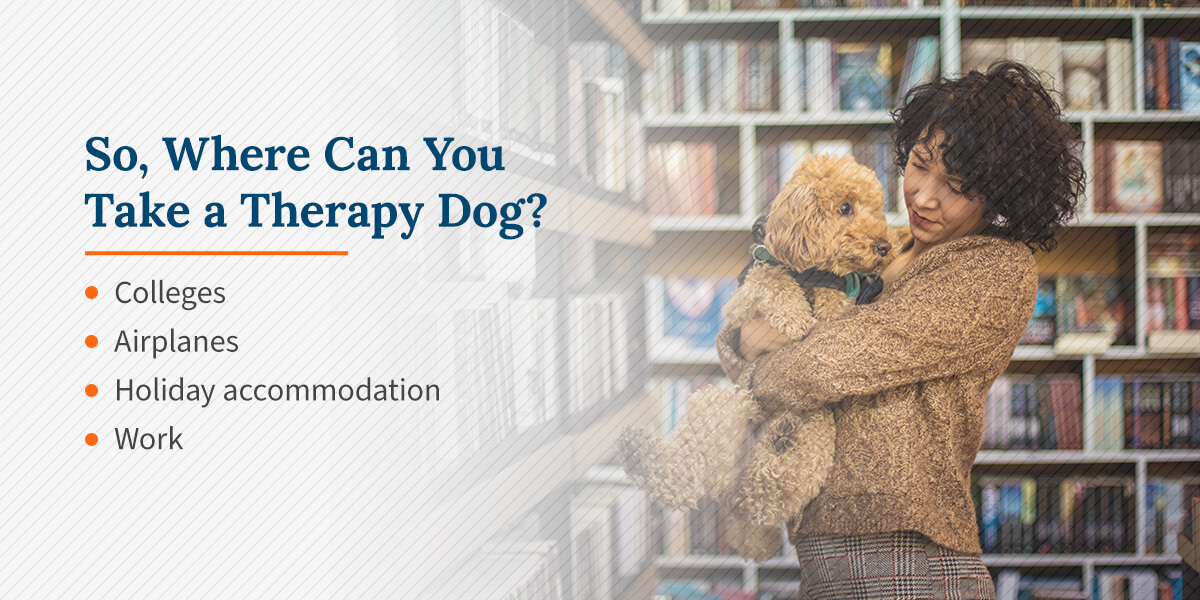Table of Contents
- What Is a Therapy Dog?
- The Difference Between Service Dogs, Emotional Support Dogs and Therapy Dogs
- Do Therapy Dogs Have the Legal Right to Enter Certain Locations?
- So, Where Can You Take a Therapy Dog?
- Should You Train Your Dog to Be a Therapy Dog?
- Types of Dog Body Language Profiles
Many misconceptions exist about what therapy dogs do and where they can go. If you have a therapy dog or you’d like to train your dog as a therapy dog, you need to know where you’re allowed to be. There are specific laws that govern the circumstances under which dogs are allowed.
There are also significant differences between therapy dogs, service dogs and emotional support animals. Each category of assistance animal is allowed to do different things. Knowing the facts about therapy dogs and their limitations is the first step to training a successful therapy dog yourself.
What Is a Therapy Dog?
Therapy dogs, also known as comfort dogs, support people’s mental health by providing emotional support and comfort. They are trained to be calm, sweet and reassuring for people facing health or emotional difficulties. Therapy dogs and their owners work as a team to improve people’s lives, whether visiting an older adult in an assisted living facility or comforting a child in foster care.
What Makes a Good Therapy Dog?
Therapy dogs must display certain characteristics in tense or anxious situations. A successful therapy dog is:
- Obedient, gentle and calm.
- Fond of socializing with different people.
- Well-mannered.
- Comfortable in new environments.
- Unbothered by unfamiliar noises and movements.
- Happy being touched and petted.
The Difference Between Service Dogs, Emotional Support Dogs and Therapy Dogs
Therapy dogs, emotional support dogs and service dogs perform different functions. While a therapy dog provides support and comfort to different people or a group of people, service animals perform specific tasks for their owners. They receive additional training aimed at helping their owners manage disabilities. The Americans with Disabilities Act (ADA) allows service dogs to accompany their owners in public places.
Service animals must be dogs, whereas a therapy animal can be any animal calm and gentle enough to provide reassurance. An example of a service dog could be a dog who guides a blind owner or helps a person with a physical disability complete daily tasks. They stay with a specific person and have special privileges in public places.
Emotional support dogs are similar to service dogs in that they help specific people. They provide emotional support to their owners, who may have a mental or emotional condition, such as anxiety or depression. While they are not trained to complete specific tasks, they are still considered essential to their owners’ well-being. They may be allowed in housing that doesn’t typically allow dogs.
Do Therapy Dogs Have the Legal Right to Enter Certain Locations?
The quick answer is no. Therapy dogs are not classified the same way as service animals, and their access to specific locations is more limited. While a therapy dog can work anywhere, the venue must invite them to the premises. Therapy dogs work closely with their owner and handler and come as a team.
Therapy dogs are not protected under federal law, so they don’t have the same access to public places as service dogs. However, they serve a vital purpose — their calm temperaments and willingness to work with various people make them invaluable in many situations. Some familiar places you might find therapy dogs include the following:
- Hospitals and mental health facilities
- Nursing homes
- Schools and libraries
- Foster care facilities
- Crisis situations such as natural disasters or accident scenes
Therapy dogs have the same legal rights as regular pets. As the owner of a therapy dog, you must ask permission before taking your dog somewhere new.
So, Where Can You Take a Therapy Dog?
If you want to take your therapy dog to various locations and lend a helping hand, all you need is an invitation. You may find that individual service providers allow you to take your therapy dog places where a regular pet would not be welcome, but it depends on the circumstances.
There is no legally protected status for therapy dogs, but you may find they’re allowed in some of the following spaces:
- Colleges: Therapy dogs have been proven highly beneficial for college students under stress, and many colleges are open to the idea. You may make an agreement with a college to bring your dog to the library or another public area once per week to interact with students.
- Airplanes: Your therapy dog is not covered by the same laws that would enable service and emotional support dogs on planes. Some airlines may allow your therapy dog to travel with you as a pet, but this is rare.
- Holiday accommodation: If you’re bringing your therapy dog to a location that requires you to travel, you may have to make special arrangements for accommodations. You might find your hotel or Airbnb allows well-behaved pets, but the venue reserves the right to tell you whether or not your dog is allowed.
- Work: Whether your dog is allowed at work is entirely up to your employer. While service dogs are legally covered in the workplace, your therapy dog requires permission before entering the building. Your employer might be open to the idea of bringing your dog to the office on certain days to interact with employees.
Many laws concerning pet ownership and access vary from one state to another. While most regulations don’t cover therapy dogs, their obedient temperaments and excellent manners make them welcome in more places than you might imagine. Always double-check with a venue before bringing your therapy dog along. You might be pleasantly surprised at the reception.
Should You Train Your Dog to Be a Therapy Dog?
If your dog has a suitable temperament to be a good therapy dog, training him is an excellent option. Dogs with calm and pleasant temperaments enjoy meeting new people, and taking them to different environments is mentally stimulating.
Often, a canine good citizen (CGC) test is a prerequisite of therapy organizations, so it’s an excellent place to start. It covers all the basics required for a therapy dog, including the following:
- Accepting a friendly stranger
- Sitting calmly for petting
- Walking through a crowd
- Sitting and staying in place
- Reaction to distractions
- Calmness around other dogs
- Obedience and coming to the handler when called
Once your dog has completed their CGC test, you may be ready to take the next step and become a therapy dog team.
Types of Dog Body Language Profiles
If you think your dog has all the makings of an excellent therapy dog, training them will be incredibly rewarding. Off Leash Canine Training Maryland can help you turn your dog into a phenomenal therapy dog. We offer a canine good citizen preparation course and a therapy dog course assessed by our in-house Therapy Pets Unlimited evaluators. After our eight private lessons, we can evaluate you and your dog as a team for certification.
Our compassionate and knowledgeable trainers are here to help you one-on-one and can provide extra individual attention to help you achieve your goals, no matter your dog’s age, breed or size. Contact us to sign up for our therapy dog training course!



